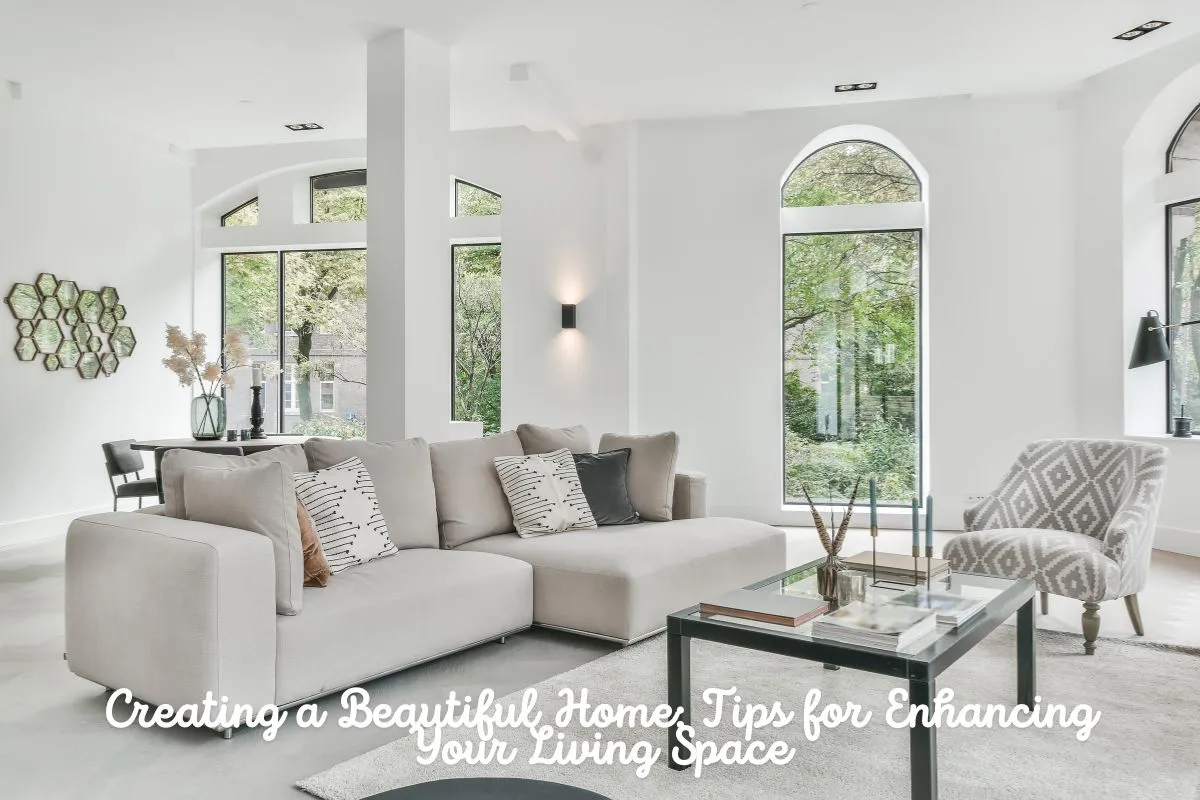A home is more than just a place to live. It’s where memories are made, where comfort is found, and where we can truly express ourselves. Creating a beautiful home doesn’t necessarily require a massive budget or a professional interior designer. With the right approach, you can transform your living space into a place that feels both stylish and inviting. In this article, we’ll explore simple yet effective tips to enhance your home, making it a space that’s not only visually appealing but also emotionally fulfilling.
Table of Contents
ToggleUnderstanding the Importance of Home Design
Home design is not just about aesthetics; it’s about creating a space that supports your well-being and reflects who you are. As famous interior designer Nate Berkus once said, “Home is where the heart is, but it’s also where the good design is” (source). Good design isn’t just about following trends; it’s about designing a space that resonates with your personality, supports your lifestyle, and creates a sense of comfort.
Personal Story: My Journey to Creating a Beautiful Home
When I first moved into my apartment, it felt like a blank canvas—white walls, basic furniture, and no personality. Over time, I started adding touches that spoke to me: a vintage rug I found at a market, soft throw pillows that made the couch more inviting, and plants that brought life to every corner. Slowly but surely, the space started to feel like my home. This experience taught me that creating a beautiful home isn’t about buying the most expensive furniture; it’s about making choices that resonate with you and creating an environment where you feel comfortable and happy.
1. Start with a Clean Slate
Before diving into decoration and design, it’s important to declutter. Research has shown that decluttering not only improves the appearance of your home but also positively affects your mental health. According to a study on the importance of decluttering and minimalism, reducing clutter can enhance life satisfaction, improve focus, and reduce stress (source). It’s amazing how much lighter and more peaceful space can feel once you remove unnecessary items.
Tip: Organize Your Space
Start by going through each room and sorting through your belongings. Keep only the items that you truly need or love. Donate or sell things that no longer serve you. Once the clutter is gone, your home will feel more spacious and inviting, providing the perfect foundation for creating a beautiful space.
2. Embrace Natural Light
Lighting plays a crucial role in the design of any room. The impact of natural light on mental health and productivity has been extensively studied. According to research on the role of natural light in interior design, sunlight can improve mood, enhance focus, and even regulate sleep patterns (source). When designing your home, take full advantage of natural light. Consider removing heavy curtains and opt for lighter window treatments that allow sunlight to pour in. If you don’t have many windows, think about how you can make a room feel brighter through the use of mirrors or light-colored walls.
Tip: Let the Sunshine In
In my living room, I replaced dark curtains with sheer white ones, which immediately made the room feel brighter and more open. I also strategically placed mirrors to reflect light and make the space feel larger. These small changes had a huge impact on how the room felt, both in terms of ambiance and mood.
3. Use the Power of Color
The colors you choose for your walls, furniture, and accessories can significantly impact the atmosphere of your home. Colors affect our emotions and can be used strategically to create the desired mood in each room. Research on the psychology of color in home decor shows that colors like blue promote calmness, while warm colors like red and orange can energize a space (source). When designing your home, think about the function of each room and the mood you want to evoke.
Tip: Choose Colors that Reflect Your Personality
In my bedroom, I chose soft blue tones because they promote relaxation and help me unwind at the end of the day. In the kitchen, I opted for brighter yellows and greens, which create a cheerful atmosphere perfect for cooking and gathering with friends. Whether you love bold colors or prefer neutral shades, choose hues that make you feel happy and at ease.
4. Personalize Your Space
Your home should tell the story of who you are. “Your home should tell the story of who you are, and be a collection of what you love,” says Nate Berkus (source). Incorporating personal touches into your space helps it feel more welcoming and meaningful. Family photos, travel souvenirs, and cherished heirlooms can all contribute to creating a space that feels uniquely yours.
Tip: Add Meaningful Details
I’ve found that adding personal mementos to my home makes it feel more authentic. In the hallway, I hang a collection of framed family photos, and on the bookshelf, I’ve placed trinkets from my travels. These small touches make my home feel more connected to me, and every time I walk through the door, I’m reminded of what’s truly important.
5. Invest in Comfortable Furniture
While aesthetics are important, comfort should always come first. “A well-designed room should not only look good but also feel good,” said interior designer Elsie de Wolfe (source). Your furniture should serve as the backbone of your design, providing both style and functionality. Whether it’s a cozy sofa for lounging or a sturdy dining table for family meals, invest in pieces that enhance your daily life.
Tip: Prioritize Comfort
When shopping for furniture, I made sure to choose pieces that weren’t just pretty to look at but also comfortable to use. My couch, for example, is not just stylish—it’s incredibly cozy, and after a long day, there’s nothing better than sinking into it. In the dining room, I opted for chairs that were supportive and comfy enough for long family dinners.
6. Incorporate Greenery
Adding plants to your home is an easy way to enhance its beauty. Not only do plants improve the air quality, but they also bring a sense of calm and nature indoors. According to the study The Impact of Interior Design on Well-being, greenery can reduce stress and improve mental health (source). From large leafy plants to small succulents, plants can be placed in almost any room and can make your home feel more vibrant and alive.
Tip: Greenery is a Game-Changer
I’ve noticed how much my mood improves when I add plants to my space. In the living room, a large fiddle-leaf fig tree brings the outdoors in, while small succulent pots on the windowsill add a subtle touch of green. Not only do the plants look beautiful, but they also make my home feel fresh and calming.
7. Add Texture and Layering
Texture is an often-overlooked element in home design, but it plays a crucial role in creating a well-rounded and cozy space. Whether it’s through soft textiles like throw blankets, pillows, and rugs or through textured furniture like wicker or velvet, adding texture can make a room feel more inviting and dynamic. Leonardo da Vinci once said, “Details make perfection, and perfection is not a detail” (source). The little details matter, and incorporating texture is one way to make your home feel more complete.
Tip: Mix and Match
To make my living room feel more comfortable and stylish, I like to mix different textures. I combine a plush velvet throw with a woven wicker chair and a soft cotton rug to create a cozy, layered look. It’s these small touches that make a room feel complete and inviting.
8. Maintain a Sense of Balance and Harmony
One of the key principles of design is balance. Good interior design creates harmony between the various elements in a room, such as furniture, colors, and textures. This balance is what makes a space feel cohesive rather than cluttered or chaotic. Massimo Vignelli, an industrial designer, said, “Good design is about making something intelligible and memorable at the same time” (source). A balanced room is both functional and memorable.
Tip: Create Balance
When arranging furniture, I always try to ensure that each piece is proportionate to the room and placed thoughtfully. For instance, I avoid crowding one side of the room with too much furniture, which could make the space feel cramped. Instead, I distribute the furniture evenly, making sure there’s enough breathing room to create a sense of balance.
Conclusion
Creating a beautiful home doesn’t require a large budget or a professional designer; it’s about making thoughtful choices that reflect who you are and make you feel at peace in your space. Whether it’s through adding personal touches, using the right colors, or incorporating greenery, these small yet impactful changes can transform your home into a place you’ll love spending time in. So take a step back, think about what makes you feel at home, and start designing a space that feels uniquely yours.
As I’ve learned through my own journey, designing your home is an ongoing process. It’s not about perfection, but about creating a space that brings joy and comfort. The beauty of a home lies not just in its design, but in how it makes you feel every day.
Share via:
Related posts:
 Okaysou Air Purifier Filter Reset: A Comprehensive Guide
Okaysou Air Purifier Filter Reset: A Comprehensive Guide
 Showpiece Safety: Protecting Your Treasures from Damage
Showpiece Safety: Protecting Your Treasures from Damage
 Walk-In Wardrobe Wishes: Creating a Dream Closet
Walk-In Wardrobe Wishes: Creating a Dream Closet
 Emergency Housing Resources in Athens, AL
Emergency Housing Resources in Athens, AL
 How to Brighten the Display on Your KitchenAid KGRS807SSS00 Oven
How to Brighten the Display on Your KitchenAid KGRS807SSS00 Oven
 Modern Minimalist Sculptures: The Beauty of Less
Modern Minimalist Sculptures: The Beauty of Less
 Kahrs Flooring: A Perfect Blend of Beauty & Durability
Kahrs Flooring: A Perfect Blend of Beauty & Durability



